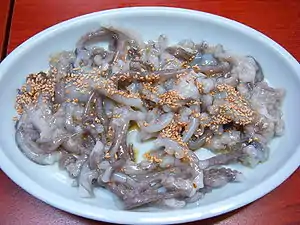San-nakji
San-nakji (산낙지) is a variety of hoe (raw dish) made with long arm octopus (Octopus minor), a small octopus species called nakji in Korean and is sometimes translated into "baby octopus" due to its relatively small size compared to the giant octopus (Enteroctopus dofleini).[1] The octopuses are most commonly killed before being cut into small pieces and served, with the nerve activity in the octopus' tentacles making the pieces move posthumously on the plate whilst served.[2][3][4] The octopus' highly complex nervous system, with two-thirds of its neurons localised in the nerve cords of its arms, lets the octopus show a variety of reflex actions that persist even when they have no input from the brain.[5][6] Less commonly, a live octopus is eaten whole.[7] The dish is sprinkled with sesame oil and toasted sesame seeds.[8]
 | |
| Type | Hoe |
|---|---|
| Place of origin | Korea |
| Associated national cuisine | Korean cuisine |
| Main ingredients | Long arm octopus |
| Korean name | |
| Hangul | 산낙지 |
|---|---|
| Revised Romanization | san-nakji |
| McCune–Reischauer | san-nakchi |
| IPA | [san.nak̚.t͈ɕi] |
Eating
Because the suction cups on the arm pieces are still active when the dish is served, special care should be taken when eating sannakji. The active suction cups can cause swallowed pieces of arm to stick to the mouth or throat.[9] This can also present a choking hazard for some people, particularly if they are intoxicated.
Language difference
Vocabularies in the two Koreas differ on nakji: South Koreans call Octopus minor, a small kind of octopus (often mistranslated as "baby octopus") nakji, while North Koreans call a squid nakji (nakchi in McCune–Reischauer romanization).
Prevalence
Sannakji is served in Korean restaurants that serve sliced raw fish, but it also can be found at bars as a snack to accompany alcoholic beverages, such as soju.
Health hazard
Consuming sannakji is potentially dangerous due to choking hazard. Because the cephalopod's limbs contain neurons, the extremities continue to move and the suction cups along its tentacles maintain their gripping power that might attach to one's throat, even after getting detached from the body and doused with sesame oil.[10] Several incidents of choking on Sannakji have been reported, such as a 2008 incident in Gwangju.[11]
See also
- Drunken shrimp, shrimp sometimes eaten alive in Chinese cuisine
- Ikizukuri, the preparation of sashimi from living animals
- Odori ebi, shrimp eaten alive in Japanese cuisine
References
- "san-nakji" 산낙지. Standard Korean Language Dictionary (in Korean). National Institute of Korean Language. Retrieved 22 February 2017.
- Rosen, Daniel Edward (4 May 2010). "Korean restaurant's live Octopus dish has animal rights activists squirming". New York Daily News. Retrieved 3 June 2017.
- Han, Jane (14 May 2010). "Clash of culture? Sannakji angers US animal activists". The Korea Times. Retrieved 4 June 2017.
- Compton, Natalie B. (17 June 2016). "Eating a Live Octopus Wasn't Nearly as Difficult As It Sounds". Munchies. VICE. Retrieved 4 June 2017.
- Hochner, B. (2012). "An Embodied View of Octopus Neurobiology". Current Biology. 22 (20): R887–R892. doi:10.1016/j.cub.2012.09.001. PMID 23098601.
- Yekutieli, Y.; Sagiv-Zohar, R.; Aharonov, R.; Engel, Y.; Hochner, B.; Flash, T. (2005). "Dynamic model of the octopus arm. I. Biomechanics of the octopus reaching movement". J. Neurophysiol. 94 (2): 1443–58. doi:10.1152/jn.00684.2004. PMID 15829594.
- Eating Live Octopus, retrieved 2018-01-13
- Warwick, Joe (30 January 2015). "The truth about Noma's live prawn dish". The Guardian. Retrieved 3 June 2017.
- "Eight controversial foods from around the world". The Times of India.
- "The Most Dangerous Foods in the World". Condé Nast Traveler. Retrieved 2018-01-18.
- Yonhap News 2008-01-21 광주서 산낙지 먹다 기도막힌 사고 잇따라
